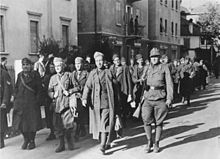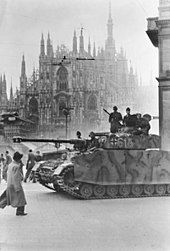Case axis
1940–1945: Air raids on Italy
1940: Attack on Taranto
1943: Operation Husky - Invasion of Italy ( Baytown , Avalanche , Slapstick ) - Armistice of Cassibile - Fall of the Axis
1944: Battle of Monte Cassino - Operation Shingle - Position of Goth
1945: Spring Offensive
Case Axis was the code name of an operation by the Wehrmacht High Command during World War II . It provided for the occupation of Italy in the event that the ally surrendered or withdrew from the war. The operation initially was known companies Alaric (after Alaric I ), but was after the arrest of Mussolini in case axis renamed.
prehistory
On July 10, 1943, the Allies landed in Sicily (→ Operation Husky ) and within the next two weeks pushed the German-Italian units back to an increasingly smaller bridgehead on Mount Etna . The resistance movements against Mussolini that had formed since the defeat in North Africa now strove for his removal. At a meeting of the Grand Fascist Council on 24./25. July Mussolini was ousted and then on the orders of King Victor Emanuel III. arrested. Pietro Badoglio was installed as the new Prime Minister .
The assurances of the Badoglio government that they wanted to remain loyal to the Axis alliance were given little credence on the German side. The plans and preparations for the takeover of the Italian occupation areas in the Balkans and France (code name: Constantine ) and for the occupation of Italy itself (code name: Alaric ), which had already been worked out at an earlier point in time, have now been reactivated and summarized in the Axis case . In addition to the German units already in Italy, troops of the newly formed Army Group B , whose headquarters were initially set up in Munich , were concentrated on the Alpine border.
The main objectives of the operation were:
- the disarmament of the Italian troops
- the fixing of the Italian fleet
- the confiscation of weapons and other military equipment
- the complete evacuation of Sardinia and Corsica
- Stabilization of the other fronts in Italy.
By overhearing a long-distance radio conversation between Roosevelt and Churchill on July 29, the German top leadership was informed of the impending armistice at an early stage.
From August 1st, eight German divisions of Army Group B advanced across the border with Italian approval and, despite Italian complaints (the Italian leadership would have advocated reinforcement of the front), gradually occupied Northern Italy. The 2nd Paratrooper Division flew in from France and took up positions around Rome . As a result, a conference took place in Tarvisio on August 6th , at which the mutual distrust was only superficially whitewashed. Indeed, by this point the Italians had already started talks with the Western Allies. A little later, preparations began for the evacuation of the Axis forces deployed in Sicily to the mainland.
course
On September 3, two British divisions landed on the Italian mainland with minimal resistance from the defenders. On the same day, the new Italian government concluded the Cassibile armistice with the Allies, but it was not announced until September 8th. Thereupon the Commander in Chief South , Field Marshal Albert Kesselring , initiated the Axis case in his area of command , in which the Germans disarmed all Italian units. Field Marshal Erwin Rommel was entrusted with carrying out the operation in northern Italy .
The OKW had feared such a development at the beginning of 1943 and in the course of the first half of 1943 strategically distributed German troops to all regions of Italy. This should ensure the quick success of the operation.
On September 10th German troops occupied Rome and on September 12th a German paratrooper command succeeded in freeing Mussolini from his captivity in the Hotel Campo Imperatore ( Operation Eiche ). Mussolini was brought to East Prussia; a little later he took over the leadership of a puppet government in northern Italy ( Republic of Salò ) and continued the fight on the German side. Also on September 10, German army groups established the Adriatic Coastal Operation Zone and the Alpine Foreland Operation Zone , which were incorporated into the Republic of Salò shortly thereafter.
The Italian fleet was largely able to evade access - only the battleship Roma was sunk by German bombers. On the Greek islands of Kefalonia and Corfu , the Italian troops stationed there fiercely resisted their disarmament. In the massacre on Kefalonia (September 21/22, 1943), more than 5,000 Italian soldiers were shot after they were captured.
Results
According to the report of Army Group B, a total of 82 Italian generals, 13,000 other officers and around 400,000 soldiers had been disarmed and taken prisoner by September 19 alone - 183,000 of these soldiers had already been transferred to internment camps in Germany. On Hitler's orders , they were not given the status of prisoners of war, but of military internees to whom the Geneva Conventions were not applied.

From September 8, 1943 to May 2, 1945, members of the Wehrmacht, SS and police in Italy murdered around 11,400 Italian military personnel, 44,720 partisans and 9,180 other men, women and children.
On October 13, the Badoglio government declared war on the German Reich. A powerful partisan army of 256,000 men and women operated alongside the remaining official Italian units , which in 1944 tied ten Wehrmacht divisions with their fighting.
The OKW's war diary referred to the time between the bugged conversation (Churchill - Roosevelt) and September 8th as
“Well used. The infiltration of an entire German army into northern and central Italy under various pretexts, while at the same time securing the pass roads and railway engineering structures occupied by the Italians, was an organizational and military-political masterpiece of the Wehrmacht command staff. It was also possible in good time to regulate the order of command in the Balkans in such a way that German units stood at all important sections or could be brought to them shortly. As a result of the early announcement of the capitulation of Italy on the evening of September 8th, the Italian armed forces were able to be disarmed so quickly that the enemy was unable to exploit this weakness of the German troops, which were initially bound by the disarming action. "
See also
literature
- Friedemann Needy , Third Reich and Second World War , Das Lexikon, Piper Verlag, 2002.
Individual evidence
- ^ War diary OKW, Volume 6, p. 1529.
- ^ Daniel Allen Butler: Field Marshal: The Life and Death of Erwin Rommel , pp. 448f. ( online )
- ^ Gerhard Schreiber : German war crimes in Italy. Perpetrator, victim, law enforcement . Beck 1996, ISBN 3-406-39268-7 . See also Fabian Grossekemper (2004): German-Italian Relations 1937–1943 ( online )
- ^ War diary OKW Volume 6, pp. 1529f.

